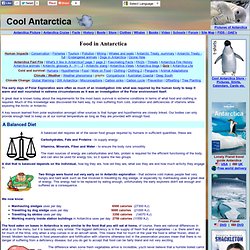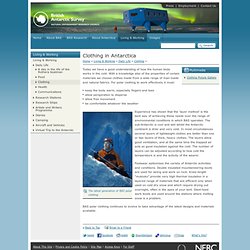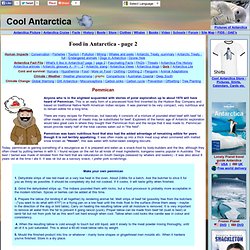

Antarctic. Food in Antarctica. The early days of Polar Exploration were often as much of an investigation into what was required by the human body to keep it warm and well nourished in extreme circumstances as it was an investigation of the Polar environment itself.

A great deal is known today about the requirements for the most basic survival in extreme conditions in terms of what food and clothing is required. Much of this knowledge was discovered the hard way, by men suffering from cold, starvation and deficiencies of vitamins while exploring the Arctic or Antarctic. A key lesson learned from polar exploration amongst other sources is that hunger and hypothermia are closely linked. Our bodies can only provide enough heat to keep us at our normal temperature as long as they are provided with enough food. A balanced diet requires all of the seven food groups required by humans in sufficient quantities, these are: Carbohydrates, Fats and Proteins - to supply energy We now know:
What clothes do you wear? Www.rte.ie/tv/tomcrean/assets/kids-corner-clothing.pdf. Clothing-sub-antarctica. Clothing in Antarctica. Today we have a good understanding of how the human body works in the cold.

With a knowledge also of the properties of certain materials we choose clothes made from a wide range of man-made and natural fabrics. For polar clothing to work effectively it must: keep the body warm, especially fingers and toes allow perspiration to disperse allow free movement be comfortable whatever the weather The latest generation of BAS polar clothing Experience has shown that the ‘layer method’ is the best way of achieving these needs over the range of environmental conditions in which BAS operates.
How do you make a fire. Antarctica Fire History. Progress Research Station - Russia - Larsemann Hills/Prydz Bay, East Antarctica - October 5th 2008 - Two Story Building MOSCOW, October 9 (RIA Novosti)A two-story building, part of Russia's Progress station in Antarctica, caught fire killing one construction worker and seriously injuring two others, the expedition's head said on Thursday.

Valery Lukin said the fire broke out on Sunday on the station, where 29 people are based, completely destroying the radio equipment, which made it impossible to contact Russian officials about the incident until Thursday. "All the radio equipment was destroyed. One of the station's construction workers... died, and two others received serious fractures and injuries," Lukin said. The injured have been taken to a nearby clinic and are receiving the necessary medical treatment. The earliest date that an evacuation could be carried out is early November. An investigation into the fire is being carried out. Antarctic Sun article Arson By email. How to Build a fire in the snow « Survival Training.
What foods do they eat? Food in Antarctica. Food in Antarctica, page 2. Pemmican Anyone who is in the slightest acquainted with stories of polar exploration up to about 1970 will have heard of Pemmican.

This is an early form of a processed food first invented by the Hudson Bay Company and based on traditional Native North American Indian recipes. It was planned to be very compact, very nutritious and to remain edible for a long time. There are many recipes for Pemmican, but basically it consists of a mixture of pounded dried beef with beef fat - other meats or mixtures of meats may be substituted for beef.
Explorers of the heroic age of Antarctic exploration would take great care in where they bought their Pemmican from and the recipe that it was made to. Pemmican was basic nutritious food that also had the added advantage of remaining edible for years though it is not terribly appetizing. Sledging Biscuits Along with Pemmican, sledging biscuits are a part of polar lore.